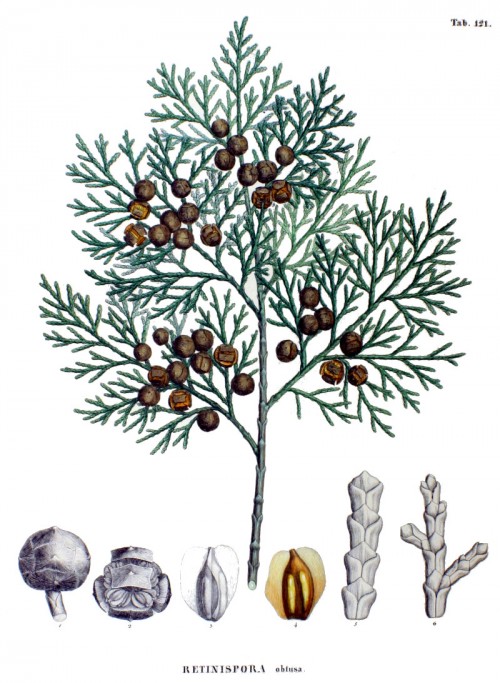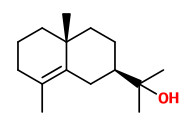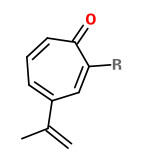Dies ist eine alte Version des Dokuments!
Chamaecyparis obtusa (Siebold & Zucc.) Endl. - syn.Cupressus obtusa K. Koch; Retinispora obtusa Siebold & Zucc. - Cupressaceae
檜 or 桧, hinoki (Jap.), Japanese cypress, hinoki, Hinoki-Scheinzypresse
Evergreen tree, up to 40m tall, native to Japan and Taiwan, naturalized and cultivated elsewhere as ornamental and for timber; bark light reddish brown, peeling off in thin strips; crown narrowly pyramidal; branches drooping to pendulous. http://www.efloras.org/florataxon.aspx?flora_id=2&taxon_id=200005410
Main components of the essential oil from the leaves of C.obtusa were elemol (14.7%), α-terpinyl acetate (9.0%), bornyl acetate (4.7%), γ-eudesmol (8.2%), β-eudesmol (6.5%), α-eudesmol (5.3%), and γ-muurolene (5.7%).
[Monoterpenoid and Sesquiterpenoid Constituents of the Essential Oil of Hinoki (Chamaecyparis obtusa (Sieb. et Zucc.) Endl.)., Shieh, B., Iizuka, Y., Matsubara, Y., Agricultural and Biological Chemistry, 45(6), 1981, 1497-1499]
Hinokitiol (thujaplicin), was not found in the neutral wood oil of C.obtusa. Yoshixol (4,4-dimethyl-6-methylene-2-cyclohexen-l-one) was regarded as major constituent the neutral wood oil. Yoshixol showed strong antibiotic effects on MRSA, Escherichia coli, Mycobacterium chelonei, Pseudomonas aureginosa and Candida albicans.
[A new substance (Yoshixol) with an interesting antibiotic mechanism from wood oil of Japanese traditional tree (Kiso-Hinoki), Chamaecyparis obtusa., Koyama, S., Yamaguchi, Y., Tanaka, S., Motoyoshiya, J., General Pharmacology: The Vascular System, 28(5), 1997, 797-804]
The acaricidal activity of C.obtusa leaves against Dermatophagoides farinae and Dermatophagoides pteronyssinus likely results from β-thujaplicin. „The active constituent of the C. obtusa leaves was identified as β-thujaplicin (C10H12O2) by spectroscopic analyses…. On the basis of a 24 h LC50 value, acaricidal activity against D. farinae was more pronounced with β-thujaplicin (72.2 mg/m2) than benzyl benzoate (89.9 mg/m2) and DEET (377 mg/m2). Acaricidal activity against D. pteronyssinus was more pronounced in β-thujaplicin (62.1 mg/m2) than benzyl benzoate (72.4 mg/m2) and DEET (193 mg/m2).“
[Acaricidal activity of active constituent isolated in Chamaecyparis obtusa leaves against Dermatophagoides spp., Jang, Y.S., Lee, C.H., Kim, M.K., Kim, J.H., Lee, S.H., Lee, H.S., Journal of agricultural and food chemistry, 53(6), 2005, 1934-1937]
„… using hinoki wood-wool to produce tatami mats is an effective method of suppressing the activity of mites for about 1 year.“
[Effect of hinoki (Chamaecyparis obtusa) wood-wool in tatami mat on the activity of house dust mite Dermatophagoides pteronyssinus., Hiramatsu, Y., Matsui, N., Ohira, T., Imai, Y., Miyazaki, Y., Journal of wood science, 52(4), 2006, 353-357]
The essential oil of C.obtusa contained α-terpinenyl acetate (14.9%), sabinene (10.9%), limonene (9.6%), α-terpinolene (7.5%), α-pinene (7.1%), 3-carene (6.1%), terpinene-4-ol (5.7%), myrcene (4.9%), γ-terpinene (4.6%), bicyclosesquiphellandrene (4.1), γ-eudesmol (3.7%), widdrene (3.5%) and cedrol (3.1%).
[Jung, J. Y., & Choi, M. S. 국내산 침엽수 추출물의 Trichoderma spp. 에 대한항균활성. Journal of Agriculture & Life Science, 45(4), 2011, 1-11]

Siebold,P.F. von, Zuccarini,J.G., Flora Japonica, t.121 (1875)
http://plantgenera.org/species.php?id_species=230171


